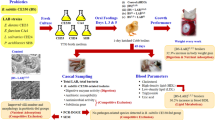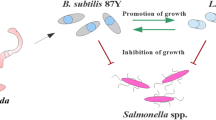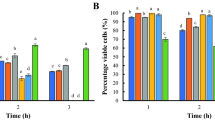Abstract
We have proposed and validate an in vitro probiotic selection, based on enzymatic potentialities associated to well-established probiotic functional properties. A new Bacillus subtilis HB2 isolate, selected based on its high extracellular enzyme production, was chosen as a probiotic candidate for application as animal feed supplement. The HB2 strain showed an excellent acid and bile salts tolerance, a strong adhesion to chick enterocytes and produced antimicrobials against pathogens. An in vivo trial in poultry farming was conducted to evaluate the HB2 probiotic performance. After 35 days, HB2 achieved the higher growth performance than the control groups. The mortality and the feed conversion ratio were significantly decreased. Finally, the HB2 treated group showed wet litter and less severe ammonia odor in the atmosphere. Our study provides new insights into the importance of enzymatic potentialities, associated with the common functional properties, as a novel approach for probiotic selection.


Similar content being viewed by others
References
Anguita M, Canibe N, Perez JF, Jensen BB (2006) Influence of the amount of dietary fiber on the available energy from hindgut fermentation in growing pigs: use of cannulated pigs and in vitro fermentation. J Anim Sci 84:2766–2778
Bareletta A (2010) Introduction: current markets and expected development. In: Bedford M, Partridge G (eds) Enzymes in farm animal nutrition, vol 2. CAB International, Wallingford, pp 1–11
Bellon-Fontaine MN, Rault J, van Oss CJ (1996) Microbial adhesion to solvents: a novel method to determine the electrondonor/electron-acceptor or Lewis acid–base properties of microbial cells. Colloid Surf 7:47–53
Bora L, Kalita M (2007) Thermozymes: an area of potential research. Curr Sci 93(5):593–594
Bundgaard AM, Dalgaard R, Gilbert C, Thrane M (2014) Assessment of the potential of digestibility-improving enzymes to reduce greenhouse gas emissions from broiler production. J Clean Prod 73:218–226
Chen W, Wang JP, Yan L, Huang YO (2013) Evaluation of probiotics in diets with different nutrient densities on growth performance, blood characteristics, relative organ weight and breast meat characteristics in broilers. Br Poult Sci 54:635–641
Collado MC, Hernandez M, Sanz Y (2005) Production of bacteriocin-like inhibitory compounds by human fecal Bifidobacterium strains. J Food Protect 68:1034–1040
Cowan ST (1985) Cowan and Steel’s manual for identification of medical bacteria, 2nd edn. Cambridge, London
Cowieson AJ (2005) Factors that affect the nutritional value of maize for broilers. Anim Feed Sci Technol 119:293–305
Del Re B, Sgorbati B, Miglioli M, Palenzona D (2000) Adhesion, autoaggregation and hydrophobicity of 13 strains of Bifidobacterium longum. Lett Appl Microbiol 31:438–442
Doi RH, Wong SL, Kawamura F (1986) Potential use of Bacillus subtilis for secretion and production of foreign proteins. Trends Biotechnol 4:232–235
Duc LH, Hong HA, Barbosa TM, Henriques AO, Cutting SM (2004) Characterisation of Bacillus probiotics available for human use. Appl Environ Microbiol 70:2161–2171
EFSA (2005) Opinion of the Scientific Committee on a request from EFSA related to a generic approach to the safety assessment by EFSA of microorganisms used in food/feed and the production of food feed additives. EFSA J 226:1–12
El-Katcha MI, Soltan MA, El-Kaney HF, El-Sayed R, Karwarie ER (2014) Growth performance, blood parameters, immune response and carcass traits of broiler chicks fed on graded levels of wheat instead of corn without or with enzyme supplementation. Alex J Vet Sci 40:95–111
García VR, Barea R, Lara L, Nieto R, Aguilera JF (2008) The effects of feeding level upon protein and fat deposition in Iberian heavy pigs. Livest Sci 114:263–273
Greenwood MW, Fritts CA, Waldroup PW (2002) Utilization of avizyme 1502 in corn-soybean meal diets with and without antibiotics. Poultry Sci 81(1):25 (abstract)
Hossain MM, Begum M, Kim IH (2015) Effect of Bacillus subtilis, Clostridium butyricum and Lactobacillus acidophilus endospores on growth performance, nutrient digestibility, meat quality, relative organ weight, microbial shedding and excreta noxious gas emission in broilers. Vet Med-CZECH 60(2):77–86
Huang T, Geng H, Miyyapuram VR, Sit CS, Vederas JC, Nakano MM (2009) Isolation of a variant of subtilosin A with hemolytic activity. J Bacteriol 19:5690–5696
Jakava-Viljanen M, Palva A (2007) Isolation of surface (S) layer protein carrying Lactobacillus species from porcine intestine and faeces and characterization of their adhesion properties to different host tissues. Vet Microbiol 124:264–273
Karimi K, Zhandi M (2015) The effect of β-mannanase and β-glucanase on small intestine morphology in male broilers fed diets containing various levels of metabolizable energy. J Appl Anim Res 43(3):324–329
Lee KW, Lillehoj HS, Jang SI, Lee SH (2014) Effects of salinomycin and Bacillus subtilis on growth performance and immune responses in broiler chickens. Res Vet Sci 97:304–308
Li Y, Xu Q, Huang Z, Lv L, Liu X, Yin C, Yan H, Yuan J (2015) Effect of Bacillus subtilis CGMCC 1.1086 on the growth performance and intestinal microbiota of broilers. J Appl Microbiol 120:195–204
Liu X, Yan H, Lv L, Xu Q, Yin C, Zhang K, Wang P, Hu J (2012) Growth performance and meat quality of broiler chickens supplemented with Bacillus licheniformis in drinking water. Asian Australas J Anim Sci 25:682–689
Mathlouthi N, Saulnier L, Quemener B, Larbier M (2002) Xylanase, β-glucanase and other side enzymatic activities have greater effect on viscosity of several feedstuffs than xylanase and β-glucanase alone or in combination. J Agric Food Chem 50:5121–5127
Mathlouthi N, Ballet N, Larbier M (2011) Influence of beta-glucanase supplementation on growth performances and digestive organs weights of broiler chickens fed corn, wheat and barley-based diet. Int J Poult Sci 10(2):157–159
Miller GL (1959) Use of dinitrosalicylic acid reagents for the determination of reducing sugar. Anal Chem 31:426–428
Mirzaie S, Zaghari M, Aminzadeh S, Shivazad M, Mateos GG (2012) Effect of wheat inclusion and xylanase supplementation of the diet on productive performance, nutrient retention and endogenous intestinal enzyme activity of laying hens. Poult Sci 91:413–425
Mitchell AJ, Vancampfort D, Sweers K, van Winkel R, Yu W, De Hert M (2013) Prevalence of metabolic syndrome and metabolic abnormalities in schizophrenia and related disorders; a systematic review and meta-analysis. Schizophr Bull 39:306–318
Park JH, Kim IH (2014) Supplemental effect of probiotic Bacillus subtilis B2A on productivity, organ weight, intestinal Salmonella microflora, and breast meat quality of growing broiler chicks. Poult Sci 93:2054–2059
Patel AK, Ahire JJ, Pawar SP, Chaudhari BL, Chincholkar SB (2009) Comparative accounts of probiotic characteristics of Bacillus spp. isolated from food wastes. Food Res Int 42:505–510
Patel AK, Singhania RR, Pandey A, Chincholkar SB (2010) Probiotic bile salt hydrolase: current developments and perspectives. Appl Biochem Biotechnol 162:166–180
Ravindran V (2013) Feed enzymes: the science, practice, and metabolic realities. J Appl Poult Res 22:628–636
Sambrook J, Fritsch EF, Maniatis T (1989) Molecular cloning: a laboratory manual, 2nd edn. Cold Spring Harbor, New York
Scott KP (2002) The role of conjugative transposons in spreading antibiotic resistance between bacteria that inhabit the gastrointestinal tract. Cell Mol Life Sci 59:2071–2082
Sharifi SD, Golestani G, Yaghobfar A, Khadem A, Pashazanussi H (2013) Effects of supplementing a multienzyme to broiler diets containing a high level of wheat or canola meal on intestinal morphology and performance of chicks. J Appl Poult Res 22:671–679
Sinol S, Ingale SL, Kim YW, Kim JS, Kima KH, Lohakarea JD, Kim EK, Kim HS, Ryu MH, Kwon IK, Chae BJ (2012) Effect of supplementation of Bacillus subtilis LS 1–2 to broiler diets on growth performance, nutrient retention, caecal microbiology and small intestinal morphology. Res Vet Sci 93:264–268
Slominski BA (2011) Recent advances in research on enzymes for poultry diets. Poult Sci 90(9):2013–2023
Tabidi MH, Mukhtar AM, Mohammed HI (2013) Effects of probiotic and antibiotic on performance and growth attributes of broiler chicks. Glob J Res Med Plants Indig Med 1(1):136–142
Thapa N, Pal J, Tamang JP (2004) Microbial diversity in Ngari, Hentak and Tungtap, fermented fish products of North-East India. World J Microbiol Biotechnol 20:599–607
Trapecar M, Leouffre T, Faure M, Jensen HE, Granum PE, Cencic A, Hardy SP (2011) The use of a porcine intestinal cell model system for evaluating the food safety risk of Bacillus cereus probiotics and the implications for assessing enterotoxigenicity. Acta Path Micro Immunol Scand 119:877–884
van Loosdrecht MCM, Lyklema J, Norde W, Schraa G, Zehnder AJB (1987) The role of bacterial cell wall hydrophobicity in adhesion. Appl Environ Microbiol 53:1893–1897
Weisburg WG, Barns SM, Pelletier DA, Lane DJ (1991) 16S ribosomal DNA amplification for phylogenetic study. J Bacteriol 173:697–703
Yang CM, Cao GT, Ferket PR, Liu TT, Zhou L, Zhang L, Xiao YP, Chen AG (2012) Effects of probiotic, Clostridium butyricum, on growth performance, immune function, and cecal microflora in broiler chickens. Poult Sci 91:2121–2129
Zhang ZF, Cho JH, Kim IH (2013) Effects of Bacillus subtilis UBT-MO2 on growth performance, relative immune organ weight, gas concentration in excreta, and intestinal microbial shedding in broiler chickens. Livest Sci 155:343–347
Zhang ZF, Kim IH (2014) Effects of multistrain probiotics on growth performance, apparent ileal nutrient digestibility, blood characteristics, cecal microbial shedding, and excreta odor contents in broilers. Poult Sci 93:364–370
Acknowledgements
This work was supported by the Tunisian Ministry of Higher Education and Scientific Research and Technology. The authors wish to express their sincere gratitude to Mr Alaa DAMMAK for his valuable collaboration.
Author information
Authors and Affiliations
Corresponding authors
Rights and permissions
About this article
Cite this article
Hmani, H., Daoud, L., Jlidi, M. et al. A Bacillus subtilis strain as probiotic in poultry: selection based on in vitro functional properties and enzymatic potentialities. J Ind Microbiol Biotechnol 44, 1157–1166 (2017). https://doi.org/10.1007/s10295-017-1944-x
Received:
Accepted:
Published:
Issue Date:
DOI: https://doi.org/10.1007/s10295-017-1944-x




